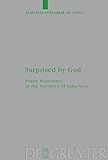Surprised by God : Praise Responses in the Narrative of Luke-Acts / Kindalee Pfremmer De Long.
Material type: TextSeries: Beihefte zur Zeitschrift für die neutestamentliche Wissenschaft ; 166Publisher: Berlin ; Boston : De Gruyter, [2009]Copyright date: ©2009Description: 1 online resource (331 p.)Content type:
TextSeries: Beihefte zur Zeitschrift für die neutestamentliche Wissenschaft ; 166Publisher: Berlin ; Boston : De Gruyter, [2009]Copyright date: ©2009Description: 1 online resource (331 p.)Content type: - 9783110221657
- 9783110221664
- 226.406 22/ger
- BS2589 .D43 2009
- online - DeGruyter
- Issued also in print.
| Item type | Current library | Call number | URL | Status | Notes | Barcode | |
|---|---|---|---|---|---|---|---|
 eBook
eBook
|
Biblioteca "Angelicum" Pont. Univ. S.Tommaso d'Aquino Nuvola online | online - DeGruyter (Browse shelf(Opens below)) | Online access | Not for loan (Accesso limitato) | Accesso per gli utenti autorizzati / Access for authorized users | (dgr)9783110221664 |
Browsing Biblioteca "Angelicum" Pont. Univ. S.Tommaso d'Aquino shelves, Shelving location: Nuvola online Close shelf browser (Hides shelf browser)

|

|

|

|

|

|

|
||
| online - DeGruyter Das mittelniederdeutsche Theophilus-Spiel : Text – Übersetzung – Stellenkommentar / | online - DeGruyter Complexity Scales and Licensing in Phonology / | online - DeGruyter Rhetoric and Theology : Figural Reading of John 9 / | online - DeGruyter Surprised by God : Praise Responses in the Narrative of Luke-Acts / | online - DeGruyter The First Book of God / | online - DeGruyter Heilig ins Eschaton : Heiligung und Heiligkeit als eschatologische Konzeption im 1. Thessalonicherbrief / | online - DeGruyter Images of Egypt in Early Biblical Literature : Cisjordan-Israelite, Transjordan-Israelite, and Judahite Portrayals / |
Frontmatter -- Contents -- Figures -- Introduction -- Part One: Praise of God in Context -- Introduction to Part One -- Chapter 1. Defining Praise of the Divine -- Chapter 2. Discourse about Praise of the Divine -- Chapter 3. Praise and Healing in Tobit -- Chapter 4. Praise and Conversion in Joseph and Aseneth -- Part Two: Praise Responses in Luke‐Acts -- Introduction to Part Two -- Chapter 5. Praise and Revelation: Jesus’ Birth -- Chapter 6: Praise and Healing in Luke‐Acts -- Chapter 7. Praise and Revelation: Jesus’ Identity as Messiah, Son, King, and Risen Lord -- Chapter 8. Praise and Conversion of the Gentiles in Acts -- Conclusions -- Backmatter
restricted access online access with authorization star
http://purl.org/coar/access_right/c_16ec
Scholars have long noted the prevalence of praise of God in Luke-Acts. This monograph offers the first comprehensive analysis of this important feature of Luke’s narrative. It focuses on twenty-six scenes in which praise occurs, studied in light of ancient Jewish and Greco-Roman discourse about praise of deity and in comparison with how praise appears in the narratives of Tobit and Joseph and Aseneth. The book argues that praise of God functions as a literary motif in all three narratives, serving to mark important moments in each plot, particularly in relation to the themes of healing, conversion, and revelation. In Luke-Acts specifically, the plot presents the long-expected visitation of God, which arrives in the person of Jesus, bringing glory to the people of Israel and revelation to the Gentiles. The motif of praise of God aligns closely with the plot’s structure, communicating to the reader that varied (and often surprising) events in the story – such as healings in Luke and conversions in Acts – together comprise the plan of God. The praise motif thus demonstrates the author’s efforts to combine disparate source material into carefully constructed historiography.
Issued also in print.
Mode of access: Internet via World Wide Web.
In English.
Description based on online resource; title from PDF title page (publisher's Web site, viewed 28. Feb 2023)


